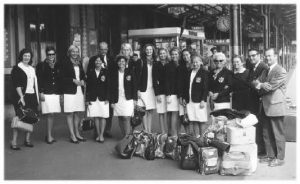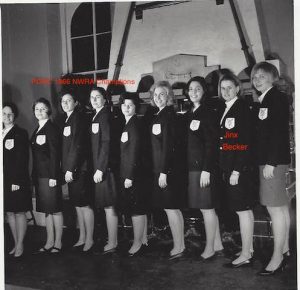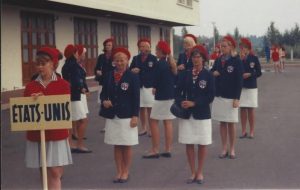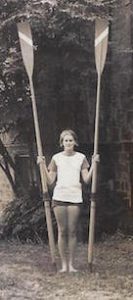
The PGRC delegation at Vichy, France, 1967: (From left) Catherine Sader; Ernestine Bayer Jr. – 7 Seat; Nancy Farrell-Stroke; Marjory Pollack Ballheim – Cox; Ernest Bayer; Evelyn Kay Bergman, 5 Seat substituting for Faye Bardman Donovan; Penny Gibson Henwood – 6 Seat; Elizabeth Griffen Bergen; Anita (Jinx) Becker Sacco – 4 Seat; Janice Saudargas – 3 Seat; Barbara DePena Hoe – 2 Seat; Sophie Socha – Bow; Ernestine Bayer Sr.; Marge Pollack; and two French officials.
Only a dozen women competed in the first Head of the Schuylkill Regatta, which may seem strange in 2020, given that about half of the nearly 8,000 HOSR competitors today are women.
But think of this: The first time American women were permitted to compete in an international competition was 1967, only three years before the first HOSR race. Those pioneering women were all from the Philadelphia Girls’ Rowing Club and the story of how they got to Vichy, France for the European Championships and what it was like being there reveals the obstacles women had to overcome to win equal footing in the sport of rowing.
Tina Bayer was among those who went to Vichy, along with her mother, PGRC founder Ernestine Bayer and her father, Ernest Bayer, who had been an officer with the Pennsylvania Barge Club and in 1967 was treasurer of the National Association of Amateur Oarsmen (NAAO). Tina described what happened behind-the-scenes that got the women to Vichy in the first place:
“My dad tried and got nowhere trying to get the girls to Vichy in 1967. Their entry was denied by the North American representative of FISA, John Carlin. He said, ‘No, the women are not in the same class as the European women. Four Bulgarian women carry their eight to the water, and the other four the oars. I’ve seen [eight of] your girls struggle to carry the boat.’ In other words, if the communists won, it would be an embarrassment to the United States.”
But through a PGRC acquaintance – a sports writer and oarsman in Ontario where the first North American Rowing Championships were being held – PGRC wrangled an invitation to compete against former Olympians in an exhibition race.
The men “had never rowed together. We had,” Tina said. “We beat them at the start and kept pace with them – and won.” Afterward, at a cocktail party, the head of FISA, Thomi Keller, approached Tina and her mother, Ernestine Bayer. “With his Swiss-German accent, he said, ‘Ernestine, I vant your girls to come to Vichy.’ ” Hearing that Carlin opposed the idea, Keller said he would lean on Carlin to agree, but the women had to meet the midnight application deadline. And there was another issue – the $6,000 it would take to get the PGRC crew –mostly clerks and secretaries – and their equipment to Vichy.
So at the reception, Ernestine approached Horace Davenport, head of the National Rowing Foundation, to ask for a grant.
“If the Foundation funded a woman’s boat, we’d probably lose all our contributors,” Davenport told Ernestine. Instead, he secretly loaned them the money. “Within a year every girl paid back the money,” Tina said. The story was never revealed until after Davenport’s death in 1991.
Anita (Jinx) Becker Sacco, one of the PGRC women who raced at Vichy, recalls the financial challenge women rowers faced. That spring she had already self-funded travel to Oakland, California for the National Women’s Rowing Association (NWRA) championships and taken vacation and unpaid leave from her secretarial job. Then she, like her fellow crew members, dug deeper to pay her way to Ontario. Suddenly Vichy was a possibility.
“We had a team meeting in Canada and decided that if we could get some funding, we would make the trip. Our benefactor at the time was anonymous. …Each of us signed an agreement that we would repay the loan in a year, and we did.” Jinx took a second job “waiting tables at Stouffers in Penn Center five nights a week so I could make my loan deadline.”
The team also had to come up with uniforms for Vichy. Their blazer, Jinx said, was a blue blazer they’d previously bought for NWRA competition from a school uniform store. “We hand-stitched the USA patches we had been issued (one of the few items given to us begrudgingly by the NAAO) over the PGRC patch we had previously sewn on the pocket.”
They also bought “on the cheap from a uniform supply house” a white polyester dress for the opening-day ceremony.
Liz Bergen recalled that Janice Saudargas, who rowed the three seat, “was walking through Wanamakers when she ran into a buyer. The woman gave us enough red, white and blue Vera scarves – very chi-chi.” They also got red woolen berets.
“Imagine our surprise and embarrassment on opening day,” said Jinx, “when we showed up for the parade and ceremonies in our dress, blazer, beret and scarf uniform only to observe all the other competitors in warm-up suits.”
“Contrast that with the U.S. men’s crews who had just about everything but a toothbrush supplied for them,” Jinx said.

PGRC’s crew at the National Women’s Rowing Association meet in Seattle in 1966. They used the same blazers for Vichy, sewing USA badges over their PGRC ones.
Recently, she learned from a Lithuanian competitor that the European women saw them as “glamorous,” setting a wardrobe precedent for succeeding years.
As Carlin had predicted, the PGRC women in Vichy were awed by the size of the Russians, who trained year-round. “I recall the Russian women as unsmiling, large and rough looking who appeared capable of hoisting multiple bales of hay,” Jinx said.
“I’m staring at this Russian who is six feet high… and the Bulgarians!,” said Sophie Socha. “The European women were subsidized. They were paid to perform their sport.“
Overall, Sophie said, the experience of Vichy was “overwhelming.”
Sophie carried a secret with her to Vichy. She was nearly three months pregnant and had told no one, not even her husband. “I never told the crew. Absolutely not! I’d have been chucked out of the boat.” As for her husband, “he was having a hard time with the notoriety we got as rowers. Once the press called him by my maiden name and he had a major meltdown.”
Liz Bergen, who made it to the race as an alternate, remembers the reception when they got off the train in Vichy. “We were met by the mayor. They took formal pictures, and made such a big deal of our arrival.” That was a contrast to their experience back home, where PGRC was still an orphan on the otherwise all-male Boathouse Row, and the women had to travel to the West Coast to find another crew to race.
So how did PGRC do at Vichy? Struggling with logistics and equipment, they had to drop out of a quad race when a rigger broke. In the eight, they came in last.

PGRC at Vichy in their cobbled-together outfits for opening ceremony. Courtesy Anita Becker-Sacco
“I came home disappointed we had not done better in competition and with a dawning appreciation of the freedoms we Americans had and took for granted,” said Jinx.
Still, PGRC was the first women’s rowing club to compete in Europe, and the presence of American women raised hopes around the world that women’s rowing would finally become an Olympic sport.
Sophie Socha came home and was soon mother of two children, but kept her links to PGRC. She has served as long-time president of the club. Jinx Becker Sacco after Vichy became the first woman to row out of Vesper, which soon after began to seriously train women for a some-day Olympics. Liz Bergen remarked on another PGRC first – racing as the first women’s crew at the Head of the Charles in 1965, though they had no competition. “We only ran a 500-meter course because they didn’t believe women could row three miles. We raced alone. We were flying the colors for women’s rowing, to open the door. “
In the late 1960s, Liz began to fill in for the secretary of the Schuylkill Navy, “because he wasn’t attending meetings.” Then, to make her the official secretary, the Schuylkill Navy, she said, had to bring PGRC in as a full member. Prior to that, “we were just the club at the end of the Row.”
By 1981, Liz Bergen was elected Commodore of the Schuylkill Navy, the first woman to hold that post – another coup for a member of the Vichy Eight.
~Dotty Brown is author of Boathouse Row, Waves of Change in the Birthplace of American Rowing. For another story about Jinx Becker Sacco, see her blog post: https://boathouserowthebook.com/2017/07/27/jinx-becker-an-early-champion-reminisces/
We are celebrating the HOSR’s 50th anniversary by highlighting 50 legendary competitors/crews/teams/coaches/influencers that have catapulted the regatta into a fall classic over the last 50 years. We celebrate the people by passing down their stories through generations, and affecting change for the future of our sport. We will publish a new story each week, continuing the celebration of our 50th anniversary, leading up to the 2021 regatta.
Watch the recording of our third ‘Story Hour’ featuring the women of the 1967 Vichy Eight.


